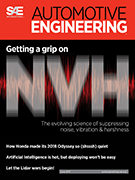Technical Paper
A Comprehensive Training Approach for Automotive Cybersecurity Engineering
2024-04-09
2024-01-2800
A significant milestone in advancing cybersecurity within the automotive industry is the release of the first international standard for automotive cybersecurity ISO/SAE 21434:2021 ‘Road Vehicles — Cybersecurity Engineering’. A recently published type approval regulation for automotive cybersecurity (UN R155) is also tailored for member countries of the UNECE WP.29 alliance. ...Thus, the challenges for embedded automotive systems engineers are increasing while frameworks, tools and shared concepts for cybersecurity engineering and training are scarce. Hence, cybersecurity training in the automotive domain necessitates an understanding of domain-specific intricacies and the unique challenges at the intersection of cybersecurity and embedded systems engineering, elevating the need for improving the skill set and knowledge of automotive cybersecurity engineers. ...Hence, cybersecurity training in the automotive domain necessitates an understanding of domain-specific intricacies and the unique challenges at the intersection of cybersecurity and embedded systems engineering, elevating the need for improving the skill set and knowledge of automotive cybersecurity engineers. This paper delves into an automotive cybersecurity training concept aimed at enhancing the proficiency of development engineers.









